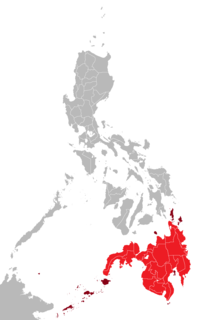
Mindanao, also commonly known as Southern Philippines, is the second-largest island in the Philippines. Mindanao and the smaller islands surrounding it make up the island group of the same name. Located in the southern region of the archipelago, as of the 2010 census, the main island was inhabited by 20,281,545 people, while the entire Mindanao island group had an estimated population of 25,537,691 (2018).

Zamboanga is a former province of the Philippines located in the western region of the southern island of Mindanao, Philippines.
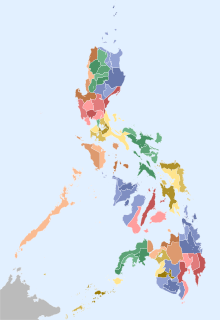
The provinces of the Philippines are the primary political and administrative divisions of the Philippines. There are 81 provinces at present, further subdivided into component cities and municipalities. The local government units in the National Capital Region, as well as independent cities, are independent of any provincial government. Each province is governed by an elected legislature called the Sangguniang Panlalawigan and by an elected governor.
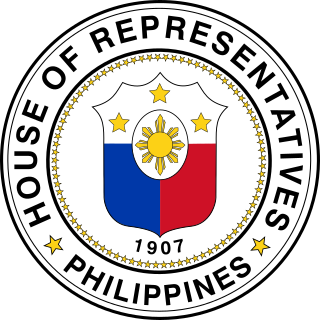
The House of Representatives of the Philippines is the lower house of the Congress of the Philippines. It is commonly referred to as Congress and informally referred to as the Cámara or Kamara.

The Autonomous Region in Muslim Mindanao was an autonomous region of the Philippines, located in the Mindanao island group of the Philippines, that consisted of five predominantly Muslim provinces: Basilan, Lanao del Sur, Maguindanao, Sulu, and Tawi-Tawi. It was the only region that had its own government. The region's de facto seat of government was Cotabato City, although this self-governing city was outside its jurisdiction.

Moro Province is the name of a former province of the Philippines consisting of the former provinces and regions of Zamboanga, Lanao, Cotabato, Davao, and Jolo. It was later split into provinces and regions organized under the Department of Mindanao and Sulu, along with the former provinces of Agusan, Surigao and current province of Bukidnon, but excluding Lanao.
The legislative district of Agusan was the representation of the historical province of Agusan in the various national legislatures of the Philippines until 1969. Butuan also remained part of the province's representation even after becoming a chartered city in 1950.
The legislative district of Zamboanga was the representation of the historical province of Zamboanga in the various national legislatures of the Philippines until 1953. The undivided province's representation encompassed the present-day provinces of Basilan, Zamboanga del Norte, Zamboanga del Sur and Zamboanga Sibugay, and the highly urbanized city of Zamboanga.
The legislative districts of Sulu are the representations of the province of Sulu in the various national legislatures of the Philippines. The province is currently represented in the lower house of the Congress of the Philippines through its first and second congressional districts.
The legislative district of Davao was the representation of the historical province of Davao in the various national legislatures of the Philippines until its dissolution in 1967.
The legislative districts of Cotabato are the representations of the province of Cotabato in the various national legislatures of the Philippines. The province is currently represented in the lower house of the Congress of the Philippines through its first, second, and third congressional districts.

The legislative districts of Sultan Kudarat are the representations of the province of Sultan Kudarat in the various national legislatures of the Philippines. The province is currently represented in the lower house of the Congress of the Philippines through its first and second congressional districts.
The legislative district of Lanao was the representation of the historical province of Lanao in the various national legislatures of the Philippines until 1969. Marawi and Iligan also remained part of the province's representation even after becoming chartered cities in 1940 and 1950, respectively.
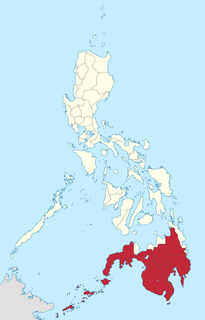
The Department of Mindanao and Sulu was an agency of the United States colonial administration in the Philippine Islands tasked to administer all Muslim-dominated areas in the territory. It was established on July 23, 1914, pursuant to Act No. 2408, replacing the Moro Province after the latter was divided into the then districts/provinces of Zamboanga, Lanao, Cotabato, Davao, and Sulu. It was later split into provinces/regions organized under the Department of Mindanao and Sulu, along with the former provinces of Agusan, Surigao and current province of Bukidnon, but excluding Lanao.

The southern island group of Mindanao in the Philippines is divided into six administrative regions. Each region is subdivided into provinces.

Misamis is a former province of the Philippines. It corresponds to the present provinces of Misamis Occidental, Misamis Oriental, Camiguin, Bukidnon, part of Zamboanga del Norte, Lanao del Sur and Lanao del Norte, and part of Cotabato.
Lanao Province was one of the former provinces of the Philippines from 1914 to 1959. Today, the province comprises Lanao del Norte and Lanao del Sur.
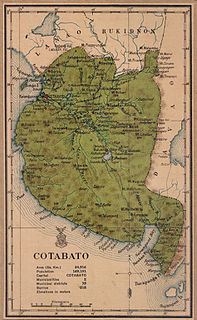
Cotabato, also known as the Empire Province of Cotabato, was a historical province of the Philippines established in 1914 that existed until its dissolution in 1973. The province's capital from 1920–1967 was Cotabato City while Pagalungan became its capital from 1967–1973.

The 1976 Tripoli Agreement was signed on December 23, 1976 in Tripoli, Libya by Carmelo Z. Barbero, representing the Government of the Philippines and Nur Misuari of the Moro National Liberation Front. The agreement defined autonomous administrative divisions for Muslims in the southern Philippines, the establishment of an autonomous government, judicial system for Sharia law and special security forces, and the observance of a ceasefire. The autonomous region was to have its own economic system, including an Islamic bank.
Philippines's 12th senatorial district, officially the Twelfth Senatorial District of the Philippine Islands, was one of the twelve senatorial districts of the Philippines in existence between 1916 and 1935. Unlike the first eleven districts which elected two members each to the Senate of the Philippines, the upper chamber of the bicameral Philippine Legislature under the Insular Government of the Philippine Islands, the two senators from this district were appointed by the Governor-General of the Philippines to serve indefinite terms in the 4th to 10th legislatures. The district was created under the 1916 Jones Law to represent the non-Christian tribes of the northern Luzon provinces of Mountain Province and Nueva Vizcaya, the city of Baguio, and the Moro people and other non-Christian tribes of the Department of Mindanao and Sulu provinces of Agusan, Bukidnon, Cotabato, Davao, Lanao, Sulu and Zamboanga.













